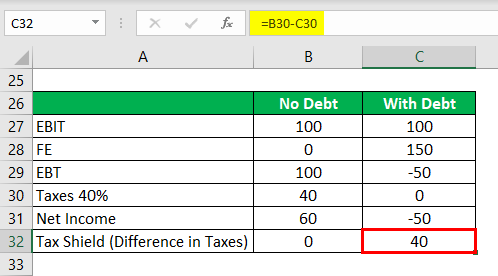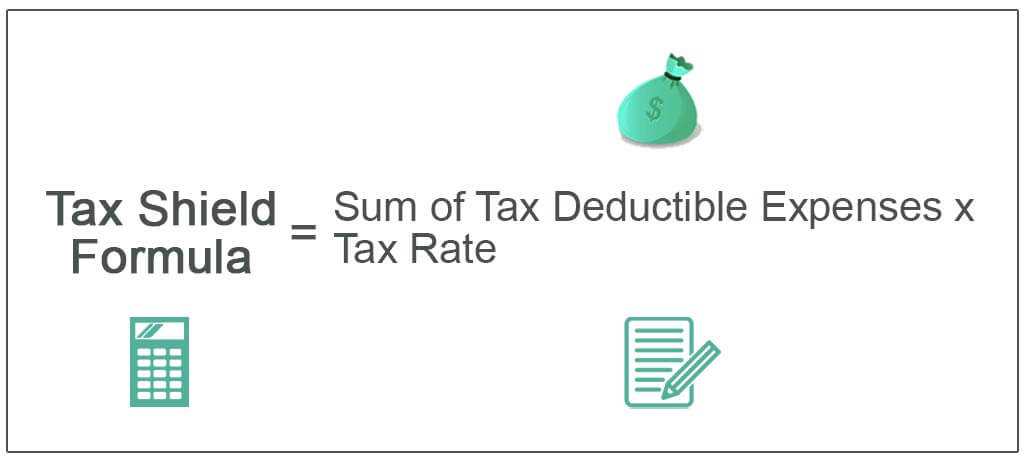Deciphering the Tax Shield Concept
A tax shield is a legal and legitimate method used by companies to reduce their taxable income, ultimately lowering their tax liability. It acts as a buffer, shielding a portion of profits from taxation. The purpose of a tax shield is to leverage deductions and allowances available under tax laws to optimize a company’s financial position. Understanding how to calculate a tax shield is essential for effective financial management.
Several types of tax shields exist. A common example is the depreciation tax shield. Depreciation is the allocation of the cost of an asset over its useful life. This depreciation expense is tax-deductible, reducing taxable income. Another example is the interest tax shield. Interest paid on debt is also typically tax-deductible. This deduction lowers the amount of income subject to tax. These tax shields encourage investment and borrowing, stimulating economic activity. Knowing how to calculate a tax shield from these sources allows businesses to make informed decisions.
Let’s illustrate with examples. Suppose a company has a depreciation expense of $50,000 and a tax rate of 21%. The depreciation tax shield would be $50,000 * 0.21 = $10,500. This represents the tax savings due to the depreciation deduction. Similarly, if a company pays $20,000 in interest, the interest tax shield would be $20,000 * 0.21 = $4,200. These examples demonstrate how to calculate a tax shield and its tangible benefits. By understanding how to calculate a tax shield, companies can strategically manage their finances and minimize their tax obligations. This knowledge empowers businesses to make informed investment and financing decisions, boosting profitability and long-term growth. Furthermore, proactive tax planning, including knowing how to calculate a tax shield, is crucial for compliance and maximizing shareholder value.
How to Determine the Value of Depreciation Tax Shield
Understanding how to calculate a tax shield related to depreciation involves several key steps. The depreciation tax shield arises because depreciation expense, while a non-cash expense, reduces a company’s taxable income. Therefore, knowing how to calculate a tax shield from depreciation is critical for financial planning. The core principle is that the tax savings are equal to the depreciation expense multiplied by the company’s tax rate.
To determine the value, one must first calculate the depreciation expense. This can be done using several methods, each yielding different results. The straight-line method is the simplest, calculating depreciation expense by subtracting the asset’s salvage value from its cost and then dividing by its useful life. For example, if a piece of equipment costs $100,000, has a salvage value of $10,000, and a useful life of 5 years, the annual depreciation expense would be ($100,000 – $10,000) / 5 = $18,000. Accelerated depreciation methods, such as the declining balance method, recognize more depreciation expense in the early years of an asset’s life. The declining balance method applies a multiple (e.g., double) of the straight-line rate to the asset’s book value each year. Once the annual depreciation expense is calculated, the tax shield is determined by multiplying this expense by the company’s tax rate. If the company’s tax rate is 25%, the depreciation tax shield from the straight-line method would be $18,000 * 0.25 = $4,500. Understanding how to calculate a tax shield requires a solid grasp of these depreciation methods.
Different assets have varying applicable depreciation rates and methods. Equipment typically depreciates faster than buildings. Tax laws and accounting standards dictate the allowable depreciation methods and useful lives for different asset classes. Businesses must adhere to these regulations to accurately calculate depreciation expense and, consequently, how to calculate a tax shield. For instance, buildings might be depreciated over 27.5 years (for residential rental property) or 39 years (for commercial property) using the straight-line method. Selecting the appropriate depreciation method and rate is crucial for maximizing the tax shield and minimizing tax liability. Improper depreciation calculations can lead to inaccuracies in financial statements and potential penalties from tax authorities. Hence, companies should carefully consider the nature of the asset and relevant tax laws when determining how to calculate a tax shield.
Understanding the Interest Expense Tax Advantage
Interest expense on debt provides a valuable tax shield for companies. This arises because interest payments are typically tax-deductible. This deduction reduces a company’s taxable income, resulting in lower tax liability. Understanding how to calculate a tax shield from interest is crucial for financial planning. The ability to deduct interest expense directly lowers the amount of profit subject to taxation, thereby improving a company’s cash flow.
The magnitude of the interest tax shield depends on several factors, including the interest rate, the amount of debt a company holds, and the company’s marginal tax rate. A higher interest rate or a larger debt balance will generally lead to a larger interest expense, which in turn increases the tax shield. The formula to calculate the interest tax shield is: Interest Expense * Tax Rate. For example, if a company has $1,000,000 in interest expense and faces a tax rate of 25%, the interest tax shield would be $250,000 ($1,000,000 * 0.25). This means the company saves $250,000 in taxes due to the deductibility of interest. Knowing how to calculate a tax shield related to interest helps in evaluating financing options.
Consider two companies: Company A and Company B. Company A relies heavily on debt financing, while Company B uses primarily equity. Company A has $500,000 in interest expense, while Company B has none. Both companies have a 21% tax rate. Company A’s interest tax shield is $105,000 ($500,000 * 0.21). This gives Company A a significant tax advantage compared to Company B. Accurately determining how to calculate a tax shield from interest is vital for making sound financial decisions. By strategically utilizing debt, companies can minimize their tax obligations and enhance their overall financial performance. Therefore, understanding the interest tax shield is essential for optimizing a company’s capital structure and tax planning.
Calculating Tax Shield from Amortization
Amortization, similar to depreciation, creates a tax shield by reducing a company’s taxable income. This applies to intangible assets that have a limited useful life, such as patents, trademarks, and copyrights. Understanding how to calculate a tax shield from amortization is essential for accurate financial planning and tax optimization. The amortization process involves systematically expensing the cost of an intangible asset over its useful life, reflecting its gradual decline in value.
To understand how to calculate a tax shield from amortization, determine the amortization expense for the period. This is typically done using the straight-line method, where the cost of the intangible asset is divided by its useful life. For example, if a company purchases a patent for $100,000 with a useful life of 10 years, the annual amortization expense would be $10,000. The amortization expense is then deducted from the company’s revenue to arrive at taxable income. To calculate the tax shield, multiply the amortization expense by the company’s tax rate. Using the previous example, if the company’s tax rate is 25%, the tax shield from amortization would be $10,000 x 0.25 = $2,500. This represents the reduction in taxes the company achieves due to the amortization deduction.
While both amortization and depreciation serve as tax shields, there are key differences. Depreciation applies to tangible assets, while amortization applies to intangible assets. Also, the methods for calculating depreciation can be more varied (e.g., declining balance) compared to amortization, which often uses the straight-line method. However, the underlying principle remains the same: both reduce taxable income and, consequently, tax liability. Properly accounting for amortization and understanding how to calculate a tax shield ensures businesses can accurately report their financial performance and optimize their tax strategies. This knowledge empowers businesses to make informed decisions regarding investments in intangible assets and their potential tax benefits. Knowing how to calculate a tax shield from amortization contributes significantly to a company’s overall financial health and tax efficiency.
The Role of Net Operating Losses (NOLs) as Tax Shields
Net Operating Losses (NOLs) represent instances where a company’s business expenses exceed its revenue in a given tax year. These losses can be leveraged as powerful tax shields, allowing companies to offset taxable income in other profitable years. This mechanism provides a significant tax advantage and promotes business stability over time. Understanding how to calculate a tax shield involving NOLs is a crucial aspect of corporate tax planning.
The primary function of NOLs as tax shields is realized through carryforward and carryback provisions. Carryforward allows a company to apply the NOL to reduce taxable income in future years, while carryback permits applying the NOL to prior profitable years, potentially resulting in a tax refund. Tax laws dictate the specific rules and limitations surrounding these carryforward and carryback periods. For instance, a company might be allowed to carry an NOL forward for 20 years and back for 5 years (these periods can change based on jurisdiction and specific tax law revisions). Strategic management of NOLs is essential. Companies must carefully analyze their financial position and projected earnings to determine the optimal timing for utilizing NOLs to minimize their overall tax burden. This involves forecasting future income and considering the applicable tax rates in different years. Proper documentation and compliance with tax regulations are paramount to successfully claim NOL deductions.
Consider a scenario where a company incurs a $500,000 NOL in Year 1. In Year 2, the company generates $300,000 in taxable income. By carrying forward the NOL, the company can offset the entire $300,000 income, resulting in zero tax liability for Year 2. The remaining $200,000 of NOL can then be carried forward to subsequent years until fully utilized, providing continued tax relief. This demonstrates how to calculate a tax shield effectively using NOLs. Furthermore, if the company had taxable income in Year 0, it might be able to carry back a portion of the NOL from Year 1 to receive a refund of taxes previously paid. This highlights the importance of understanding the nuances of NOL rules and regulations to maximize tax savings and optimize financial performance. Effective planning related to NOLs ensures companies can navigate periods of financial difficulty while maintaining long-term financial health. Learning how to calculate a tax shield using strategies like managing NOLs is invaluable.
A Practical Example: Calculating a Combined Tax Shield
To illustrate how to calculate a combined tax shield, let’s consider a fictional company, “Tech Solutions Inc.” Tech Solutions purchased new equipment for $100,000, using a loan with an annual interest rate of 5%, resulting in an annual interest expense of $5,000. The equipment is depreciated using the straight-line method over 5 years, resulting in an annual depreciation expense of $20,000 ($100,000 / 5). Additionally, Tech Solutions amortized a newly acquired patent for $10,000 over 10 years, leading to an annual amortization expense of $1,000. The company’s corporate tax rate is 25%.
First, we calculate the depreciation tax shield. The depreciation expense of $20,000 reduces taxable income. This reduction results in tax savings of $5,000 ($20,000 * 0.25). Next, we determine the interest tax shield. The $5,000 interest expense reduces taxable income, yielding a tax savings of $1,250 ($5,000 * 0.25). Finally, the amortization of the patent creates an additional tax shield. The $1,000 amortization expense reduces taxable income resulting in a tax savings of $250 ($1,000 * 0.25). To calculate the total tax shield, we sum the individual shields: $5,000 (depreciation) + $1,250 (interest) + $250 (amortization) = $6,500. This demonstrates how to calculate a tax shield incorporating multiple factors. Learning how to calculate a tax shield effectively is crucial for financial planning.
This example showcases how to calculate a tax shield by combining depreciation, interest, and amortization. Understanding how each component contributes to the overall tax savings is vital. Remember that accurately calculating the tax shield requires precise accounting of all deductible expenses. The total tax shield of $6,500 represents the reduction in Tech Solutions Inc.’s tax liability due to these deductible expenses. This method is applicable to various businesses and helps in understanding how to calculate a tax shield for financial decision-making. Understanding how to calculate a tax shield is key for optimizing tax strategies.
Tax Shield Analysis: A Step-by-Step Approach
To effectively learn how to calculate a tax shield, a systematic approach is crucial. This involves identifying all applicable tax shields within a company’s financial structure. Begin by compiling relevant financial data, including depreciation expenses for fixed assets, interest expenses on debt, and amortization expenses for intangible assets. Accurately determining these figures is essential for a precise tax shield calculation. Understanding how to calculate each component individually is fundamental to achieving an accurate overall calculation.
Next, calculate the tax savings generated by each individual shield. For depreciation, multiply the depreciation expense by the applicable tax rate. Repeat this process for interest expense and amortization expense. Remember, the tax rate will influence the final tax shield value significantly. Consider the implications of changes in tax law when performing this calculation. This detailed breakdown ensures precision and accuracy when learning how to calculate a tax shield. This step-by-step method helps mitigate errors and guarantees a more reliable outcome.
Finally, sum the tax savings from each individual shield to obtain the total tax shield. This represents the overall reduction in tax liability resulting from the utilization of all available tax advantages. One can then analyze the total tax shield against the company’s overall tax burden to evaluate its effectiveness in mitigating tax obligations. This comprehensive approach to how to calculate a tax shield provides a clear picture of the financial benefit derived from these strategic tax planning measures. Companies can use this data to make informed decisions for future financial planning. Regularly reviewing and updating this calculation remains essential to reflect changing business circumstances and tax regulations.
Factors Influencing the Size and Effectiveness of Tax Shields
The size and effectiveness of tax shields are not static; they respond dynamically to various internal and external factors. Understanding these influences is crucial for accurate tax shield calculations and effective tax planning. Changes in tax laws, for instance, directly impact the tax rate used in computations. A reduction in corporate tax rates lowers the value of each tax shield, while an increase has the opposite effect. Similarly, economic downturns can affect a company’s profitability, influencing depreciation deductions and interest expenses, thereby altering the overall tax shield. Furthermore, understanding how to calculate a tax shield accurately requires considering the impact of changes in the value of assets subject to depreciation. Fluctuations in market prices can alter depreciation calculations, particularly using methods that reflect asset value. How to calculate a tax shield in a given year hinges on the current economic climate and asset values.
Company-specific strategies also play a significant role. A company’s capital structure—the proportion of debt to equity financing—directly affects the interest expense tax shield. Higher levels of debt lead to larger interest deductions, increasing the tax shield, but also increase financial risk. Similarly, investment decisions significantly impact depreciation tax shields. Investing in assets with longer useful lives or employing accelerated depreciation methods can increase short-term tax savings, while impacting later years. Strategic tax planning involves careful consideration of these factors to maximize the benefits of tax shields while mitigating potential risks. Businesses must consider the interplay between debt levels, asset purchases, and tax regulations to optimize how to calculate a tax shield effectively. Accurate forecasting of these variables is key to effective tax planning and ensuring the tax shield calculations remain relevant.
Adapting tax shield calculations to account for these variables requires a proactive and dynamic approach. Regular reviews of tax laws and economic forecasts are essential. Sensitivity analyses, which examine the impact of changes in key variables on the tax shield, provide valuable insights into potential risks and opportunities. Sophisticated financial modeling can help companies simulate various scenarios and understand the implications of different strategic choices on their overall tax burden. By proactively monitoring these factors and incorporating them into their calculations, companies can ensure their tax shield computations remain accurate, relevant, and supportive of their long-term financial strategies. Ultimately, mastering how to calculate a tax shield involves continuous monitoring and adaptation to maintain accuracy and exploit opportunities for optimization.



